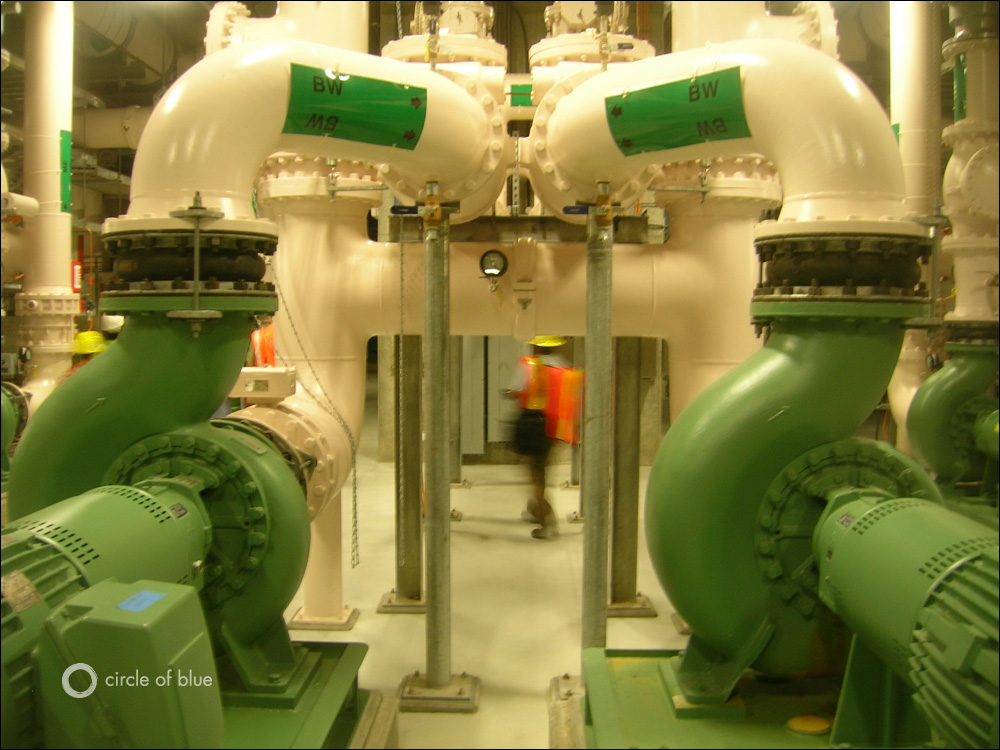U.S. Sewer Costs Increase 5.5 Percent in 2013, Industry Survey Reveals
Why? Old pipes, clean water regulations, and years of inadequate investment.

By Brett Walton
Circle of Blue
Clean water is getting more expensive.
Average sewer charges for U.S. households increased 5.5 percent in 2013 to $US 435 per year, according to an annual survey from the National Association of Clean Water Agencies, a group that represents the wastewater industry.
The most expensive sewer charges in 2013 were in New England, where an average family pays $US 700 per year for sewage treatment and disposal. The lowest charges are found in the upper Great Plains, where $US 225 buys a year’s worth of sewer services.
NACWA expects sewer costs to increase roughly 5 percent annually over the next five years.
–Chris Hornback,
National Association of Clean Water Agencies
Several factors account for sewer costs that are rising faster than inflation. Federal regulations are clamping down on cities that dump untreated sewage into rivers and lakes. Years of inadequate investment have put utilities in a financial hole that they are trying to climb out of. Some cities are still riding a wave of investment that occurred immediately after the Clean Water Act was passed in 1972.
A common feature underlies both aspects, said Chris Hornback, senior director of regulatory affairs at NACWA. Most utilities operate an old network of pipes and treatment plants that need a makeover, he explained.
“Looking back to the 1980s, the [rate] increases haven’t been sufficient to maintain the assets, to upgrade, repair, and replace what’s needed,” Hornback told Circle of Blue. “Rates are playing catch up.”
The rising cost of sewer services mirrors the rising cost of drinking water in the United States. Last week, Circle of Blue released its annual survey of water prices, finding that the average cost of water climbed 6.2 percent in 2013 in 30 major U.S. cities.
Breaking Down the Numbers
NACWA sent its survey, which dates to 1985, to 280 utilities, asking them to submit the average annual household sewer cost for their service area. Two-thirds of the utilities, serving 108 million people, responded.
NACWA calculated the regional and national averages by weighting the numbers according to population. That means an increase in New York or Chicago would influence the total more than an increase in Tulsa or Tacoma. The 10 regions correspond to the U.S. Environmental Protection Agency’s regional divisions.
The methodology is not as precise as NACWA’s triennial rate survey – which assesses sewer costs based on various levels of water use, as well as breaking down fixed charges and variable volume rates – but Hornback said the annual survey is an easier number for policymakers to understand.
Some of the largest annual charges occur in cities that have signed agreements with state and federal regulators to reduce the amount of sewage dumped into rivers and lakes during heavy rains – “combined sewer overflows,” or CSOs in the technical lingo.
At least 40 cities nationally are under a federal consent decree, as these agreements are called. Hornback cited Atlanta – annual sewer charges of $US 1,055 – as one example.
A number of water utility leaders have pushed back recently against U.S. Environmental Protection Agency regulations that they say put too great a financial burden on their communities. The EPA has responded by testing an integrated planning process that allows cities to sequence their sewer investments so that those that provide the most benefit are completed first.
Yet evidence of combined sewer overflows does not correspond directly with rate increases. Hornback pointed to the Midwest as a region with a high concentration of CSOs but relatively low sewer charges.
“There’s a lag in rates catching up with the needs,” he said, referring to the region that stretches from Minnesota to Kentucky and wraps around the western half of the Great Lakes.
Hornback offered two reasons for New England’s high costs: older infrastructure compared to other reasons and a political willingness to increase rates in order to invest in new facilities.
Willing or not, the rest of the country will likely follow New England’s higher-cost path.
Brett writes about agriculture, energy, infrastructure, and the politics and economics of water in the United States. He also writes the Federal Water Tap, Circle of Blue’s weekly digest of U.S. government water news. He is the winner of two Society of Environmental Journalists reporting awards, one of the top honors in American environmental journalism: first place for explanatory reporting for a series on septic system pollution in the United States(2016) and third place for beat reporting in a small market (2014). He received the Sierra Club’s Distinguished Service Award in 2018. Brett lives in Seattle, where he hikes the mountains and bakes pies. Contact Brett Walton











I wonder how many Florida utilities participated in the survey. It appears that some communities in Florida pay a higher rate than what is reported.
Second thought, wouldn’t It be more efficient to treat water at its source and maintain it onsite?
Bob, The numbers from the study are averages – both for an average household (as defined by each utility) and by geographic region. In Florida’s region, some 29 utilities responded. There certainly will be significant variation. If a household uses more water, sewer costs for that household will be higher. Some cities have higher costs than others.
Your second comment goes to the heart of the new urban water infrastructure movement. There’s green infrastructure which seeks to build local, grassy catchments on rooftops, sidewalks, or parks that mimic wetlands. Then there are rainwater tanks that can hold even more water (and reduce your water bill). And grey-water infrastructure, which recycles the water from showers and sinks. The goal for all this is to avoid the large centralized treatment plants and stormwater-holding basins, which come with a multibillion-dollar price tag for large cities.